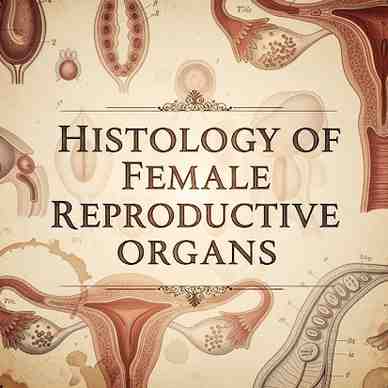
Your Account
Designed by Zeptt Technologies

The female reproductive system consists of internal genital organs: uterus, fallopian tubes, cervix, vagina, and ovaries.
Histologically, these organs exhibit cyclical changes governed by hormones.
They are derived from Mullerian ducts (except ovaries) and develop embryologically from the intermediate mesoderm.
SANSKRIT REFERENCE
अर्थववहिनी स्त्रीणां योनिः स्थानं गर्भधारणे ।
बीजाशयस्तु गर्भस्य बीजसंचयनं स्मृतम् ॥
(As per Ayurvedic texts, Yoni, Garbhashaya, and Beejashaya correspond to vagina, uterus, and ovary respectively.)
HISTOLOGY OF UTERUS
LAYERS
Perimetrium: Outer serosal layer, part of visceral peritoneum.
Myometrium: Thick smooth muscle layer; contains 3 layers – inner longitudinal, middle circular (rich in blood vessels), outer longitudinal.
Endometrium: Inner mucosal lining, shows cyclical changes. Two zones:
Stratum functionalis – shed during menstruation
Stratum basalis – regenerates functional layer
EPITHELIUM
Lined by simple columnar epithelium with both ciliated and secretory cells.
Endometrial glands are tubular and embedded in lamina propria.
CYCLICAL CHANGES (as per BD Chaurasia)
Proliferative phase – Glands are straight and narrow.
Secretory phase – Glands become coiled and tortuous, stromal edema increases.
Menstrual phase – Functional layer sheds with bleeding.
HISTOLOGY OF FALLOPIAN TUBE
LAYERS
Mucosa: Highly folded, with simple columnar ciliated and secretory (peg) cells.
Muscularis: Inner circular and outer longitudinal smooth muscle.
Serosa: Peritoneal covering.
MUCOSAL REGIONS
Infundibulum and Ampulla – Highly folded mucosa, numerous ciliated cells for ovum transport.
Isthmus – Less folded, thicker muscular wall.
Intramural part – Passes through uterine wall, narrow lumen.
FUNCTION
Ciliary movement and peristalsis aid in ovum transport and sperm movement.
SANSKRIT VIEWPOINT
अर्थववाहिन्यः स्रोतांसि तत्र सङ्गच्छते शुक्रं च बीजं च
– Fallopian tube is the anatomical basis of artavavaha srotas.
HISTOLOGY OF CERVIX
EPITHELIUM
Ectocervix (Portio vaginalis) – Stratified squamous non-keratinized epithelium.
Endocervix (Canal) – Simple columnar epithelium forming deep crypts.
TRANSFORMATION ZONE
Area between squamous and columnar epithelium (important for pathology – cervical carcinoma develops here).
GLANDS
Endocervical mucosa contains mucus-secreting tubular glands (produce cervical mucus).
No shedding of endometrial lining – no cyclical bleeding.
HISTOLOGY OF VAGINA
LAYERS
Mucosa: Non-keratinized stratified squamous epithelium; no glands.
Lamina propria: Elastic fibers and lymphocytes.
Muscularis: Inner circular and outer longitudinal smooth muscle.
Adventitia: Dense connective tissue.
FEATURES
Epithelium rich in glycogen – metabolized by lactobacilli to lactic acid, maintaining acidic pH.
Rugae are present in mucosa, especially in reproductive age.
SANSKRIT CORRELATION
योनिः स्त्रीणां गर्भमार्गः स एव सुखदुःखयोः ।
– Vagina is referred to as yoni, the passage for menstruation, intercourse, and childbirth.
HISTOLOGY OF OVARY
COVERING
Germinal epithelium: Simple cuboidal cells.
Tunica albuginea: Dense connective tissue under epithelium.
TWO REGIONS
Cortex: Contains ovarian follicles (primordial, primary, secondary, Graafian), corpus luteum, corpus albicans.
Medulla: Loose connective tissue with blood vessels, lymphatics, nerves.
FOLLICULAR DEVELOPMENT
Primordial follicle – Single layer of squamous cells.
Primary follicle – Cuboidal granulosa cells appear.
Secondary follicle – Antrum formation.
Graafian follicle – Large antral follicle with oocyte, zona pellucida, corona radiata.
CORPUS LUTEUM
Formed after ovulation; secretes progesterone and estrogen.
If no pregnancy, degenerates to corpus albicans.
SANSKRIT VIEWPOINT
बीजाशयः सञ्जातीनां कारणं बीजसंभवः ।
– Ovary is the Beejashaya, the source of female germ cells (ova).
MODERN CLINICAL ANATOMY (BD CHAURASIA)
Endometrial biopsy – Assesses hormonal response and uterine health.
Pap smear – Cervical epithelium screening for dysplasia.
Laparoscopic view – Used to visualize tubes and ovaries.
PCOS, Endometriosis – Linked to abnormal ovarian and endometrial histology.
Tubal block – Detected by histological abnormalities or hysterosalpingography.
Cancer sites – Cervix (transformation zone), endometrium (hyperplasia), ovary (surface epithelium origin).